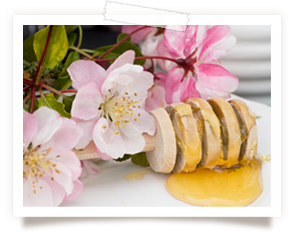Honey products

Working wonders for health and beauty.
The wonders that little bees can achieve with their organisation and distribution of work are astonishing. Their honeycombs, constructed from the finest beeswax, are like works of art. Drop by drop they gather nectar and honeydew to produce wonderful, sweet honey. At the same time they collect a varied mixture of pollen, which contains many valuable nutrients.
Pollen is the basis for royal jelly, a nutritional drink that boosts the queen bee's size and fertility.
Propolis, the complex putty-resin compound of the bees, has still not been completely decoded by scientists. Yet all these bee products are beneficial to human health. This even includes bee venom, which is also used for healing purposes.
The sweet energiser
The most important and well-known product of the bees is honey. For us it's a sweet and yet healthy foodstuff. Bee colonies produce honey as a provision in bad times. In summer nectar, honeydew and pollen are the bees' energisers. In order to preserve them for winter, they remove the water and add enzymes. The honey produced is stored in the honeycombs, left to mature and covered for protection.
The foundation for fascinating structures
Bees that are responsible for building honeycombs produce a colourless wax in their wax glands. With this they produce the fascinating hexagonal structures.
In the beehive, the wax discolours and, over time, takes on a yellow to reddish-brown colour as it ages. A popular use of beeswax is to make candles.
Additionally it's used to make cosmetics and medicine. In the food industry beeswax serves as a coating agent, for example to prevent jelly babies sticking together.
A valuable source of protein
Pollen plays a role in the reproductive process of plants. When they gather nectar, bees automatically carry pollen from one bloom to the next and sprinkle it over the plants. At the same time, protein-rich pollen is an important food for the bee brood. That's why bees carry pollen into the hive and store it in the honeycomb.
Liquid magic for the royals
"Royal jelly" is the name for a special drink that is reserved for the queen bee. It contains an especially large amount of protein and is produced by the worker bees, mainly through the ingestion of protein-rich pollen. Ordinary bee larvae only receive a slightly watered-down version of this valuable juice during the first three days to enable them to develop their body structure. Only the queen bee is fed with royal jelly throughout her life. She becomes significantly larger and receives enough easily-digestible protein to enable her to lay hundreds of thousands of eggs.
The healing resin
Propolis is the resin of the bees, with which they seal the hive and actually mummify invading enemies. The main source is tree resin, which the bees knead together with pollen balsam, wax and honey into a smooth mixture.
Essential oils and plant dyes are regarded as the key active ingredients in this medically interesting bee glue. Propolis acts as a disinfectant and preservative.
It is traditionally used as a natural antibiotic and for wound healing.
Remedy for rheumatism
Bees produce a venom in a gland in their abdomen. A bee sting is unpleasant for humans but not necessarily dangerous. Only when a person is stung many times or is particularly sensitive to the venom can it lead to health problems. In the right dosage, bee venom even acts as a remedy, for example for rheumatic diseases, because it promotes local blood circulation.
Bee venom consists of a complex mixture of many diverse substances,
80% of which are proteins. These cause the allergic effect of the venom and lead to the swelling at the entry point on the skin.
